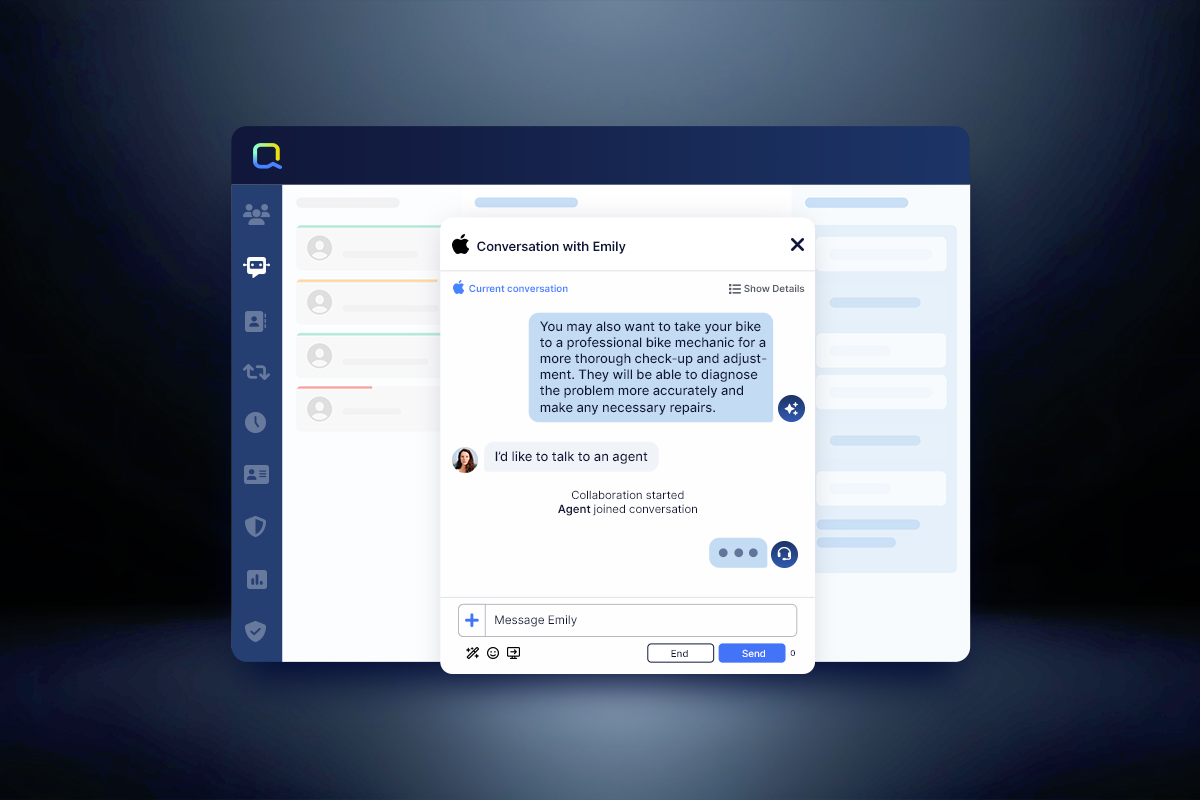Customer service has come a long way since the first contact centers. These days, most complaints are dealt with through a customer service platform, and those platforms are often focused on using chat to communicate.
In this piece, we’ll discuss customer service chat platforms, comparing various features you should be looking out for and how they’ll help your business. Let’s get going!
Key takeaways:
- Customer service remains incredibly important, and there’s a ton of data to back that up.
- More and more companies are turning to customer service platforms because they help you fit better into busy customers’ schedules, leverage advanced tools like generative AI, and provide a world-class experience.
- When evaluating a potential platform, there are a few things you should keep in mind. It should support many different channels (from email and voice to Facebook Messenger and Wechat), it should allow you to have humans do what they’re best at and AI systems do what they’re best at, and you should be able to build a CRM, helpdesk, knowledge base, or agent workspace on top of it without too much difficulty.
Why You Should Be Using a Customer Service Chat Platform
As professionals in the customer service arena, you probably already understand why it’s important to have a dedicated customer service platform–especially when it enables chat.
Still, it’s worth pointing out how compelling the data supporting this conclusion is. High-quality customer service is a huge selling point, as 4 out of 10 customers indicate they will split with a business over bad service (this figure has been considerably higher in prior years). All told, it’s been estimated that U.S. businesses have lost as much as $1.6 trillion when customers switch after having a bad encounter with customer service.
On the other hand, the data also paints a clear picture of how valuable your reputation can be, as 68% of survey respondents have said they will select your company if you are well-known for being helpful and courteous.
How Can a Chat-Based Customer Service Platform Help?
Having said that, here are some of the high-level benefits that accrue to companies that invest in good customer service chat platforms:
- Meeting your customers where they’re at: A good platform will give you many ways of talking to your customers, which means they can choose the option that makes the most sense given their schedules and preferences. Consult the next section for more information on customer service chat channels.
- You can integrate with generative AI: The big story of the past few years has been the rise of large language models, with concomitant changes in how contact centers run. You’ll want to vet your platforms to make sure they’ll allow you to leverage this technology–as well as related abilities like advanced natural language processing and sentiment analysis–as it’s rapidly becoming tablestakes.
- Personalization: One of the other significant applications of modern machine learning is tailoring content to each person’s tastes (think of how Netflix or Spotify learn what shows and music you like and recommend more of it). Using something like retrieval-augmented generation (RAG), you can draw on a customer’s prior interactions or purchases to answer their questions in a way that speaks to their unique circumstances.
- You can gather better data for KPIs: It’s hard to know whether your strategies are working unless you have the right data. Quality customer service platforms make gathering and analyzing customer data a breeze.
- Your agents can be more productive: Between generative AI, automation features, self-serve, and live chat, a customer service chat platform can make your agents far more effective. This acts to boost customer satisfaction and agent satisfaction at the same time.
The Main Customer Service Chat Channels–And How to Use Them
Okay, now let’s discuss some available options. There’s a lot to cover here, so we’ve chosen to break things up like this:
- Customer service channels are the actual applications you use to talk to your customers, like voice chat, email, SMS, Apple Messages for Business, or WhatsApp.
- Customer service modes are what we call the ways you use your channels, with the three big categories being “speaking to a human agent,” “speaking with an AI agent,” and “speaking with a mix of both.”
- Customer service platforms are what we call products like Quiq, Zendesk, etc., that serve these capabilities through a user interface.
In the sections below, we’ll discuss all three.
The Major Customer Service Channels
- Web chat has become a standard-issue channel for many websites. Everyone from energy companies to car dealerships has a portal on their web pages that allows you to speak with either a human or AI agent, and this is something you should offer as well.
- SMS and rich chat are both crucial channels, given how prevalent phones have become. Many customers find they prefer the convenience of dealing with agents through text messages, as this enables asynchronous conversations that fit better into busy lives. Through multimedia messaging service (MMS), SMS can send more than text–it can handle pictures, videos, emojis, audio, buttons, carousel cards, quick replies, and more. Rich messaging supports this natively, so you have multiple options for creating engaging interactions with your customers.
- Voice (over the phone) was once one of the dominant ways of handling customer service issues. Though it has lost a lot of ground to texting, email, and chat, it’s still worth having a phone number people can call if they need to.
- Email is, of course, thoroughly embedded into modern life, and is a common way of communicating. You’re almost certainly already supporting email, and if you’re not, you should be.
- WhatsApp for Business–a messaging, voice, and video-calling application managed by Meta–boasts over two billion users worldwide. Given its widespread use for texting, it has become a favored platform for businesses looking to utilize instant messaging for commercial purposes.
- Facebook Messenger is another service Meta provides that customer-centric businesses should consider, especially due to its large user base. Furthermore, companies implementing effective automation solutions on Facebook Messenger can respond to 80% of incoming customer inquiries and attain customer satisfaction rates up to 95%.
- Instagram Messenger is important because many members of your audience are already engaging with businesses on the widely-used Instagram platform. Additionally, its appealing API facilitates the setup of automation, enhancing the efficiency of your business.
- Apple Messages for Business greatly enhances your customers’ access to your business by providing a “message” icon on Maps, Siri, Safari, Spotlight, or your company website, along with other contact options such as QR codes. Furthermore, the widespread popularity of Apple and its product ecosystem underscores why you should be investing in its instant messaging capabilities.
- WeChat is an extremely popular platform in China, boasting over a billion users. Similar to the other platforms we’ve discussed, WeChat offers a Business version that enables you to interact with customers, market your services, and process payments. However, setting up a WeChat Business account requires verification of your business license. If you have a substantial customer base in China, this could be the optimal choice.
| Convenient | Asynchronous | Scalable | AI integrations | |
| Web chat | Limited | Limited | Yes | Yes |
| SMS, MMS, and Rich Messaging | Yes | Yes | Yes | Yes |
| Voice | Limited | No | No (but will become more scalable as AI voice models improve, see next column) | Kind of (voice models are getting good, and the best vendors already have multimodal voice support.) |
| Limited | Yes | Yes | Yes | |
| Messaging Application (Facebook, WhatsApp, etc.) | Yes | Yes | Yes | Yes |
The Major Customer Service Modes
Now, let’s discuss the basic ways of using a customer service communication channel.
Human agents
Obviously, the original way of solving issues was to have a human manually walk through all the steps. The customer service industry remains large in part because there are many aspects of the “human touch” that cannot be automated or replaced.
This is one huge advantage of using human agents, and it’s why we’ll still need humans for a long time. The downside, of course, is that people need breaks, time off, and to sleep, or else they’ll burn out.
AI agents
Until just a few years ago, the best we could do with AI systems was build brittle, rule-based chatbots that were of limited use. That’s no longer the case, and today’s language models can handle many queries directly, or else route to the most qualified human being.
The advantages of AI agents are that they can scale almost infinitely, can work all day and night, and can almost instantly handle complex tasks like translating between different natural languages. The disadvantage of AI agents is that there are still many issues that they simply can’t handle.
A mix of both
But the real power lies in what are commonly called “centaurs,” i.e., systems combining human ingenuity and flexibility with the scalability of AI.
This will look different for different situations, but a common centaur setup is to have routine issues solved by an AI agent, and everything else sent to a human based on its content and priority. Even then, however, AI can be of enormous use. Quiq’s Human-Agent Assistants, for example, use AI to suggest replies to humans, making both the AI component and the human component of the system more effective.
This means you can allow humans and machines to play to their respective strengths, but it can take time and effort to get everything configured and running smoothly.
| Human agents | AI agents | Centaurs | |
| Adaptable | Yes | Limited | Yes |
| Infinitely scalable | No | Yes | No |
| Needs breaks | Yes | No | Yes (the human part) |
How This Figures Into Picking the Right Customer Service Chat Platform
Now, we’ll close the section by discussing customer service chat platforms like Quiq.
Today, most of these platforms offer functionality like data tracking, CRMs, various communication channels, and native support for generative AI. If you choose a good one, you’ll be able to create reports about the effectiveness of different agents, how happy your customers are on average, how long it takes you to resolve issues, etc. They should also make it easy for you to incorporate your own data sources–a knowledge base, a product catalog, an API–so that you can personalize replies across channels.
Another thing to look out for is how easy a given platform makes it to set up a helpdesk or knowledge base (or to incorporate an external one). The former allows you to track tickets and manage your agent workflows (another thing that AI agents can help with), while the latter offers resources customers can use to resolve their own problems. Both are important.
| CRM | Help Desk | Knowledge Base | Agent workspace | |
| Supports customer segmentation and bespoke communication | Yes | Yes | No | Yes |
| Gives granular data insights into customers | Yes | No | No | Yes (but only if the vendor has robust data integrations) |
| Facilitates multi-channel communication | Yes | No | No | Yes |
| Supports templates | Yes | Yes | Yes | Yes |
| Enables automation | Yes | Yes | Yes | Yes |
| Can integrate with other tools (including AI) | Yes | Yes | Yes | Yes |
Getting Customer-Centric Chat Right
We’ve offered a lot of context about how to think about customer service chat platforms, but one thing we haven’t discussed is the difference between rolling your own solution vs. going with a third-party platform.
It’s a big topic, involving non-trivial tradeoffs on either side. To get up to speed as quickly as possible, check out our whitepaper!




